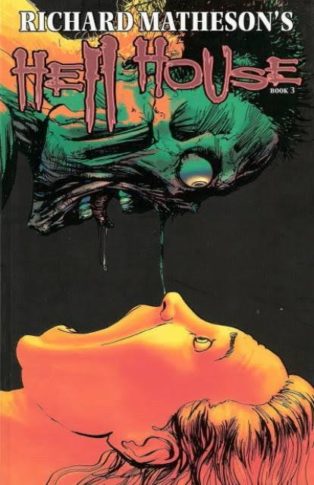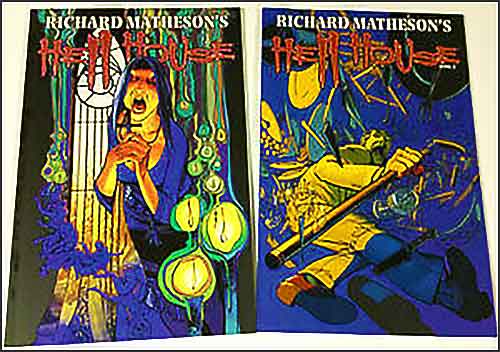 By RICHARD MATHESON, IAN EDGINTON, SIMON FRASER (IDW; 2008)
By RICHARD MATHESON, IAN EDGINTON, SIMON FRASER (IDW; 2008)
Richard Matheson’s novel HELL HOUSE, originally published in 1971, is widely considered one of the premiere splatterpunk texts. Matheson, in his 1950s masterworks I AM LEGEND and THE SHRINKING MAN, laid the groundwork for the modern horror novel, and HELL HOUSE was in its own way every bit as influential. It’s certainly among the most explicit haunted house stories ever written in its depiction of sex and violence. It’s also a rare example of a book that actually delivers on its wildly ambitious premise.
…it’s also a rare example of a book that actually delivers on its wildly ambitious premise.
That premise concerns a dying man who pays a team of scientists and spiritualists to spend a week in a vast, forbidding abode known as Hell House. Apparently the “Mount Everest of haunted houses,” it was built by a depraved millionaire who created a literal Hell on Earth within. So haunted is this place that since the original owner’s (apparent) death nearly everyone who’s stayed therein has either died or gone insane.
This graphic novel adaptation by Ian Edginton fully captures the rawness of Matheson’s novel, in direct contrast to THE LEGEND OF HELL HOUSE, the watered-down 1973 film version.
This graphic version is quite frank in depicting the book’s hard-R rated elements, courtesy of black and white illustrations by Simon Fraser, who also has a knack for capturing partially illuminated scenes wherein much of the image is shrouded in darkness (and likes to depict his characters in the act of screaming or grimacing).
This graphic novel version is quite frank in depicting the book’s hard-R rated elements…
 Among the horrors shown here is a ghostly presence that hides under sheets and is privy to violent attacks. There’s also ectoplasm that flows from a woman’s nose and mouth during a séance to coalesce into a separate face over the one it emitted from. Another memorable encounter takes place in a steam room, which is considerably toned down from that of the book but still quite unnerving.
Among the horrors shown here is a ghostly presence that hides under sheets and is privy to violent attacks. There’s also ectoplasm that flows from a woman’s nose and mouth during a séance to coalesce into a separate face over the one it emitted from. Another memorable encounter takes place in a steam room, which is considerably toned down from that of the book but still quite unnerving.
Then there’s the sexual content, which was unprecedented for 1971 and is still quite strong. There are episodes of lesbianism, masturbation and, in the book’s single most memorable sequence, necrophilia, wherein a woman’s erotic fantasy becomes something else altogether.
Then there’s the sexual content, which was unprecedented for 1971 and is still quite strong.
It almost seems like in HELL HOUSE Richard Matheson was making explicit what Shirley Jackson only implied in her classic HAUNTING OF HILL HOUSE. But Matheson also brings much of his own to the tale, including an intriguing conjecture that Hell House’s haunting may be caused by a psychic energy field that lets loose the characters’ own buried desires rather than the traditional ghosties from without.
Of course all this is thrown up in the air in a final twist that I’ve never been too enthusiastic about. Matheson, remember, was one of the key writers for THE TWILIGHT ZONE, and was often twist-ending happy. I’m not sure this particular story needs a twist, however, as it more than stands on its own without it.
